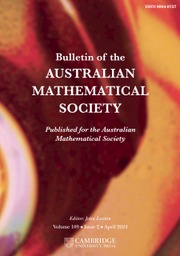No CrossRef data available.
Article contents
DIMENSIONAL APPROXIMATION OF AN INHOMOGENEOUS ATTRACTOR WITHOUT ANY SEPARATION CONDITION
Part of:
Classical measure theory
Published online by Cambridge University Press: 23 June 2025
Abstract
We show that the Hausdorff dimension of the attractor of an inhomogeneous self-similar iterated function system (or self-similar IFS) can be well approximated by the Hausdorff dimension of the attractor of another inhomogeneous self-similar IFS satisfying the strong separation condition. We also determine a formula for the Hausdorff dimension of the algebraic product and sum of the inhomogeneous attractor.
Keywords
Information
- Type
- Research Article
- Information
- Bulletin of the Australian Mathematical Society , Volume 112 , Issue 3 , December 2025 , pp. 515 - 527
- Copyright
- © The Author(s), 2025. Published by Cambridge University Press on behalf of Australian Mathematical Publishing Association Inc
Footnotes
The Author acknowledges support from the grant NKFI KKP144059 ‘Fractal geometry and applications’.
References
Baker, S., Fraser, J. M. and Máthé, A., ‘Inhomogeneous self-similar sets with overlaps’, Ergodic Theory Dynam. Systems 39(1) (2019), 1–18.CrossRefGoogle Scholar
Bárány, B., ‘On some non-linear projections of self-similar sets in
 ${\mathbb{R}}^3$
’, Fund. Math. 237 (2017), 83–100.CrossRefGoogle Scholar
${\mathbb{R}}^3$
’, Fund. Math. 237 (2017), 83–100.CrossRefGoogle Scholar
Bárány, B., Käenmäki, A. and Nissinen, P., ‘Covering number on inhomogeneous graph-directed self-similar sets’, Preprint, 2023, arXiv:2307.16263.Google Scholar
Barnsley, M. F. and Demko, S., ‘Iterated function systems and the global construction of fractals’, Proc. Roy. Soc. Lond. Sect. A 399 (1985), 243–275.Google Scholar
Chandra, S. and Abbas, S., ‘On fractal dimensions of fractal functions using function spaces’, Bull. Aust. Math. Soc. 106 (2022), 470–480.CrossRefGoogle Scholar
Dubey, S. and Verma, S., ‘Fractal dimension for a class of inhomogeneous graph-directed attractors’, Discrete and Continuous Dynamical Systems - Series S (2024), doi:10.3934/dcdss.2024158.CrossRefGoogle Scholar
Dubey, S. and Verma, S., ‘Inhomogeneous graph-directed attractors and fractal measures’, J. Anal. 32 (2024), 157–170.CrossRefGoogle Scholar
Falconer, K. J., ‘The Hausdorff dimension of some fractals and attractors of overlapping construction’, J. Stat. Phys. 47 (1987), 123–132.CrossRefGoogle Scholar
Falconer, K. J., Fractal Geometry: Mathematical Foundations and Applications (Wiley, New York, 1999).Google Scholar
Farkas, Á., ‘Projections of self-similar sets with no separation condition’, Israel J. Math. 214(1) (2016), 67–107.CrossRefGoogle Scholar
Farkas, Á., ‘Dimension approximation of attractors of graph directed IFSs by self-similar sets’, Math. Proc. Cambridge Philos. Soc. 167(1) (2019), 193–207.CrossRefGoogle Scholar
Fraser, J. M., ‘Inhomogeneous self-similar sets and box dimensions’, Studia Math. 213 (2012), 133–156.CrossRefGoogle Scholar
Fraser, J. M., Assouad Dimension and Fractal Geometry, Cambridge Tracts in Pure Mathematics, 222 (Cambridge University Press, Cambridge, 2020).CrossRefGoogle Scholar
Hutchinson, J. E., ‘Fractals and self-similarity’, Indiana Univ. Math. J. 30 (1981), 713–747.CrossRefGoogle Scholar
Jha, S. and Verma, S., ‘Dimensional analysis of
 $\alpha$
-fractal functions’, Results Math. 76(4) (2021), 1–24.CrossRefGoogle Scholar
$\alpha$
-fractal functions’, Results Math. 76(4) (2021), 1–24.CrossRefGoogle Scholar
Mauldin, R. D. and Urbański, M., ‘Dimensions and measures in infinite iterated function systems’, Proc. Lond. Math. Soc. (3) 73 (1996), 105–154.CrossRefGoogle Scholar
Mauldin, R. D. and Urbański, M., ‘Conformal iterated function systems with applications to the geometry of continued fractions’, Trans. Amer. Math. Soc. 351(12) (1999), 4995–5025.CrossRefGoogle Scholar
Mauldin, R. D. and Williams, S. C., ‘Hausdorff dimension in graph directed construction’, Trans. Amer. Math. Soc. 309(2) (1988), 811–829.CrossRefGoogle Scholar
Nussbaum, R. D., Priyadarshi, A. and Lunel, S. V., ‘Positive operators and Hausdorff dimension of invariant sets’, Trans. Amer. Math. Soc. 364(2) (2012), 1029–1066.CrossRefGoogle Scholar
Olsen, L. and Snigireva, N., ‘
 ${L}^q$
spectra and Rényi dimensions of in-homogeneous self-similar measures’, Nonlinearity 20 (2007), 151–175.CrossRefGoogle Scholar
${L}^q$
spectra and Rényi dimensions of in-homogeneous self-similar measures’, Nonlinearity 20 (2007), 151–175.CrossRefGoogle Scholar
Orponen, T., ‘On the distance sets of self-similar sets’, Nonlinearity 25 (2012), 1919–1929.CrossRefGoogle Scholar
Peres, Y. and Shmerkin, P., ‘Resonance between Cantor sets’, Ergodic Theory Dynam. Systems 29 (2009), 201–221.CrossRefGoogle Scholar
Priyadarshi, A., ‘Lower bound on the Hausdorff dimension of a set of complex continued fractions’. J. Math. Anal. Appl. 449(1) (2017), 91–95.CrossRefGoogle Scholar
Verma, S., ‘Hausdorff dimension and infinitesimal similitudes on complete metric spaces’, Preprint, 2021, arXiv:2101.07520.Google Scholar


